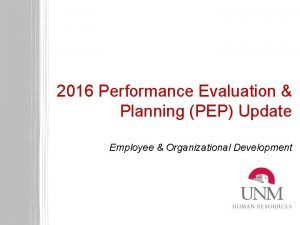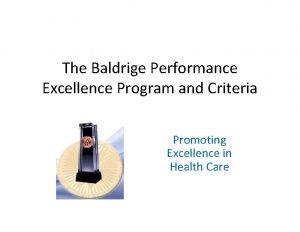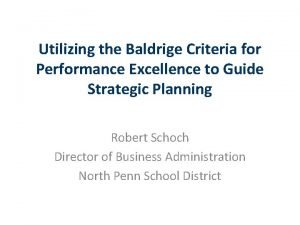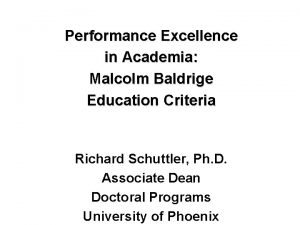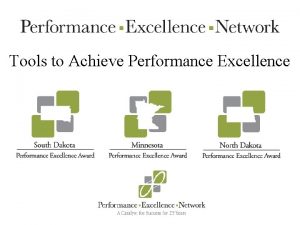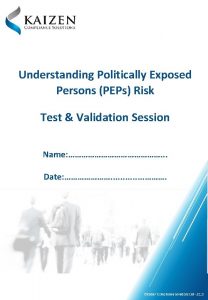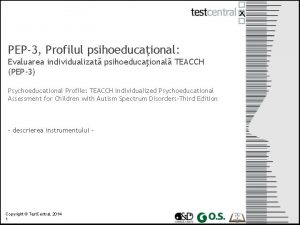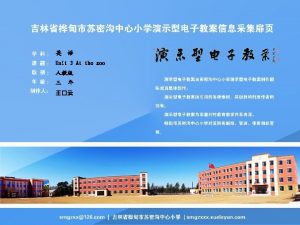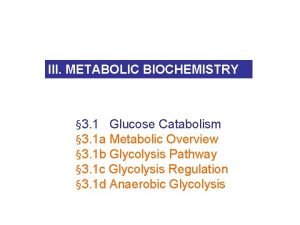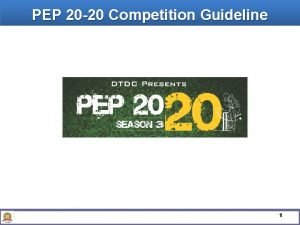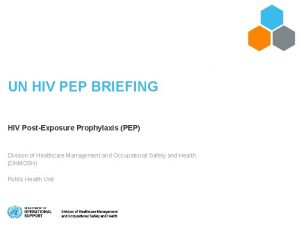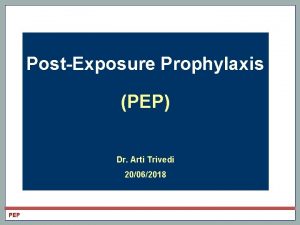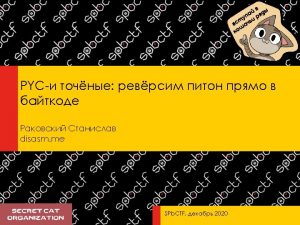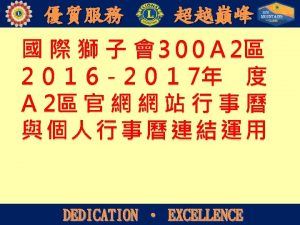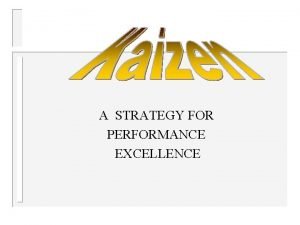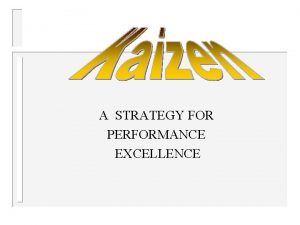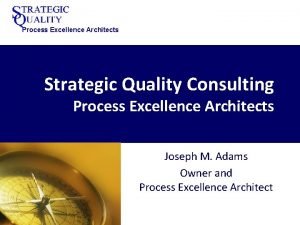Performance Excellence Process The Performance Excellence Process PEP












- Slides: 12


Performance Excellence Process The Performance Excellence Process (PEP) is an In 2001, the Performance Excellence Process replaced the integral part of our Xerox Lean Six Sigma strategy. The Managing for Results process and local-level performance Performance Excellence Process is how we align strategies and performance objectives across the entire corporation. It also is how we manage performance to ensure we management processes and integrated them into a single, global process for the corporation. PEP is applicable to all performance levels (Operating Unit, Organization/ Function, Department, Team/ Workgroup, Individual). deliver value to our customers. The result is that we The Performance Excellence Plan helps us document our deliver improved and profitable business results that objectives, measures and targets. increase shareholder value. This allows us to reinvest A management process is implemented at every level in the growth of our company. of Xerox and provides structured opportunities for PEP is based on sound quality principles and effective performance management. The process consists of three phases, as shown in the PEP diagram below: • Setting direction • Deploying direction • Delivering and inspecting results (daily work processes) Individual Objectives (Performance Excellence Plans) setting direction, communicating direction, and delivering and inspecting results.

A Core Value Five Principles to Live Our Core Value We deliver quality and excellence in all we do. Five principles were defined to represent the Quality means leading the market with innovative Ø enactment of the Xerox Quality Value: products, services and solutions that are highly valued by our customers and result in superior business performance. Xerox Lean Six Sigma will be the way we achieve Customer-focused employees, accountable for business results, are fundamental to our success. Ø Our work environment enables participation, speed and teamwork based on trust, learning and recognition. Ø Everyone at Xerox has business objectives aligned to the superior business performance and customer value. Xerox direction. A disciplined process is used to assess Our Xerox Lean Six Sigma methods and tools progress toward delivery of results. enable our people to continually focus on the Ø Customer-focused work processes, supported by disciplined customer, create higher levels of customer value use of Lean Six Sigma tools, enable rapid changes and yield and improve business results. predictable business results. Ø Everyone takes responsibility to communicate and act on benchmarks and knowledge that enable rapid change in the best interest of customers and shareholders.

Performance Excellence Process Principles Setting Direction Ø Direction setting is completed by the Corporation and Business Groups by November. Deploying Direction – Employee and Manager Role Ø The first step in deploying direction is for individuals to understand the direction set by the corporation. Ø In December or early January, everyone receives the following information (hard-copy or Web-based): Ø The Corporate Direction and Performance Excellence Plan Ø Organization Direction and Performance Excellence Plan with specific measures and targets, as appropriate Ø Appropriate Unit/ Team Level PEP Document Ø The manager and employee/team agree on critical performance objectives, measures and targets that are specific and challenging and that support the delivery of the organization objectives. Ø The manager and employee agree on a Personal Developmental Plan. Ø Everyone at Xerox will have a written Performance Excellence Plan and Personal Developmental Plan by the end of January or early February 2005. Delivering and Inspecting Results – Employee and Manager Role Ø Each organization’s management process provides structured opportunities for performance management. Ø The manager and employee/team are jointly responsible for managing both job performance and development. Ø The manager provides coaching and feedback to employees/ teams on an ongoing basis. It is recommended that every Xerox employee receive, at a minimum, two (2) performance reviews annually: Ø Interim (mid-year) coaching and feedback session Ø Annual (year-end) performance review Ø When assessing performance, the focus is on results delivered against the measures and targets. Additional information can be found at: http: //xww. docushare. world. xerox. com/dsweb/View/ Collection-138359

Performance Excellence Process Principles Vision Enduring Values Ø We succeed through satisfied customers. do great work…” by constantly leading in Ø We value and empower our employees. document technologies, products and services Ø We deliver quality and excellence in all we do. Ø We require premium return on assets. Ø We use technology to develop market leadership. Ø We behave responsibly as a corporate citizen. Our vision is “helping people find better ways to that improve our customers’ work processes and business results. Mission Therefore, our mission is to become change agents / innovators – using Xerox Lean Six Sigma to constantly search for a better way to 2005 Goals Ø Improve customer experience new technologies, products and services that Ø Grow revenue enable better results for our customers. Ø Improve profitability and cash flow Ø Create a great employee experience meet our customers’ challenges… and to create



Interim Overall Summary (for Interim Review) Summarize the employee's/team's overall performance for the interim. Include the impact of situational factors or constraints. Year-End Overall Summary (for year-end review) Summarize the employee's/team's overall performance for the full year. Include the impact of situational factors or constraints. We have discussed and agreed upon the above performance objectives and measures / targets. We have completed the interim review. We have completed the year-end review. Employee Signature Date Employee Signature Date Manager Signature Date 2 nd Level Manager Signature (if required by your organization) Date 2 nd Level Manager Signature (if required by your organization) Date NOTE: As part of the interim review session, please complete a Personal Development Plan (52164)



Role of Management Team: Shared accountability for the performance and development of the European business Leadership Strategy Culture Executio n Structure Develop and maintain: A clearly stated and focused European strategy A common high performance culture Flawless operational execution Clear and simple structures Demonstrate and develop collective leadership: Values and behaviour Business ethics Talent

Decision: behaviours to support the role of Management Team Focus Make Decisions Take Action Full Contribution Work Together Respect others Helpful • Concern for the • Come prepared, good of the with the data and a whole business view • Demonstrate • Everyone can state sensitivity to the decision made local markets • ‘closed loop’ focus – discussion, decision, implementation • Champion customer and employee Helpful • Do what we say we will do • Measure what we set out to do • Finish what we started Helpful • Clarify nature of contribution required • Take steps to get everyone’s view on the table • Acknowledge when we don’t know Helpful • Invite input from others • Settle bilateral differences outside meeting • Share ideas and experience • Share ownership Helpful • Seek to understand each other, and guests • Accurately restate the opinion of others outside meeting • Act the same inside and outside meetings • No mail, SMS, PC during meeting Unhelpful • Excessive focus on the past • Lack of attention to practical priorities Unhelpful • Procrastination • Sit back and let others do the • Responsibility for talking action unclear • Lose sight of the outcome Unhelpful • Stay within boundaries • Get bogged down in the detail of others’ work • Provide insight when not adding value Unhelpful • Spend time on other business during meetings • Engage in side conversations Unhelpful • Take decisions that others can make • Cannot articulate the nature of the decision • Jump to a decision before everyone has had the opportunity to input
 Unm pep
Unm pep Baldrige performance excellence program
Baldrige performance excellence program Performance excellence network
Performance excellence network Malcolm baldrige criteria for performance excellence
Malcolm baldrige criteria for performance excellence Baldrige education
Baldrige education How to achieve performance excellence
How to achieve performance excellence Peps test
Peps test Kellogg's pep vitamins advertisement analysis
Kellogg's pep vitamins advertisement analysis Emfysemblåsor
Emfysemblåsor Pep 3
Pep 3 Pep zoo zip
Pep zoo zip Tunesflux
Tunesflux Reversible reactions in glycolysis
Reversible reactions in glycolysis
